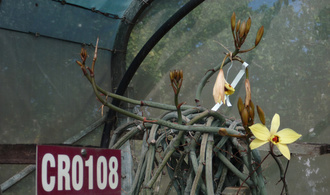Focus on a species of vanilla from the Comoros and Mayotte
Written by Modified on the
The many species of unknown vanilla represents a unique genetic potential, the study of which is still very important. The lack of genetic diversity of commercial vanilla crops means worldwide production is target for possible biological pests. Rodolph Gigant has a PhD in Genetics from the UMR-PVBMT and has dedicated part of his thesis to Humblot vanilla, endemic to Mayotte and the Comoros. He says:
"We study the diversity of wild vanilla plants to improve commercially-grown crop species with similar species that could bring vital new traits. We know, for example, that of leafless Humblot vanilla can cope easily in dry conditions. When we think of all the problems caused by Fusarium, a soil fungus that destroys the root system and causes wilting of plants, if you are able to create new species from the Humblot vanilla, by crossing and sexual reproduction, one might be able to generate a new species that could survive in drier conditions, which would limit the impact of Fusarium wilt. This can be a source of disease resistance".
A species threatened with extinction
Unlike Vanilla planifolia, the most cultivated species in the world, which flourishes in moist tropical zones, the Humblot vanilla is adapted to dry tropical forests. The Humblot vanilla is leafless and cactus-like. This is the most drought-resistant species of vanilla currently known. The tools developed during research on Humblot vanilla will ultimately contribute to its preservation, and will also be used to study other species of wild vanilla in the Indian Ocean threatened by habitat destruction (crop burning, clearing and invasive crops). Studying and protecting species of wild vanilla would enrich genetic knowledge and could eventually improve the species currently cultivated. "Rodolph Gigant’s PhD thesis has improved knowledge of the Humblot species. We now know much more about its reproductive biology, genetic structure, pollination biology, etc.. This knowledge can help conserve the species since it is on the verge of extinction, but also to feed the little knowledge we have at the moment of the multitude of species of vanilla in the world.” emphasizes Luc Gigord of the Botanical Conservatory of the Mascareignes.
Genetic diversity as a defensive weapon
From these studies, everyone agrees that the greater the genetic diversity of a species of vanilla, the greater its potential to respond to environmental changes. Humblot vanilla is a small-scale equivalent of the current world situation: low genetic diversity, the slightest disturbance could, to some extent, have serious consequences for the world’s vanilla plantations. For Rodolph Gigant, the idea is to characterize individuals from a genetic point of view and know where they can be found. The aim is to study their genetic diversity and propose conservation solutions. If we observe that there are different types of individuals, we can put some genotypes in the collection. We have a collection of genetic resources in Réunion, at the Biological Resource Centre (BRC) Vatel, which includes about thirty species of vanilla. To propose conservation solutions, genetics remains the best neutral and objective way to study the diversity of individuals and the variability of a species. Molecular tools will help define whether or not there is genetic diversity. Individuals which are unique genotypes can be used in collections and in “re-introductions” where habitat destruction has occured.
The research tools developed for the study of Humblot vanilla have identified ways to prevent its disappearance. These tools are now used in the Comoros to ensure conservation of the species. On a broader scale, the study on Humblot vanilla could serve as a basis for further research on hundreds of species of wild vanilla and the mysteries of their genetics, thus contributing to the protection and improvement of vanilla around the world.


